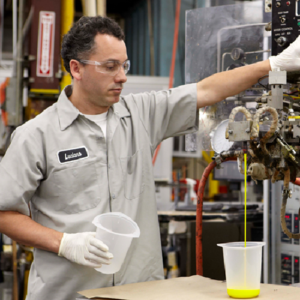 Urethane is the name given to a class of NCO (isocyanate) terminated resins with cross linking or chain extension intermediates called curing agents. Urethane is often used as an alternative term for polyurethane.
Urethane is the name given to a class of NCO (isocyanate) terminated resins with cross linking or chain extension intermediates called curing agents. Urethane is often used as an alternative term for polyurethane.
Basically, polyurethane is a polymer — a chemical compound or mixture of compounds formed by polymerization and consisting of repeating structural units. Some of the repeating units are urethane groups — a chemical linkage of a specific assembly of atoms in a particular pattern.
Urethane is a chemical group consisting of (R1-O-CO-NH-R2) and polyurethane is a material that incorporates many urethane groups.
This being the case, there is no difference between a urethane part and a polyurethane part — they are all made up of urethane groups. The term polyurethane simply means there are multiple urethanes being used.
There are ten major groups of urethanes:
The name given to a class of NCO (isocyanate) terminated resins with cross linking or chain extension intermediates called curing agents. Urethane is often used as an alternative term for Polyurethane. There are ten major groups of urethanes:
- MDI-Polyesters: Produce FDA dry and wet food grade urethanes in the normal hardness range from 85 Durometer A to 45 Durometer D. They are tough, abrasion resistant and tear resistant.
- TDI-Polyester: Produces urethanes from 50 Durometer A to 75 Durometer D which are tough, abrasion resistant, and with excellent oil and aliphatic solvent resistance.
- MDI-Polyethers: Produce urethanes with higher resilience, better impingement type abrasion resistance, good dynamic performance, improved hydrolysis resistance and excellent low-temperature properties. Some are adaptable to FDA and USDA application for wet and dry food contact.
- TDI-Polyethers: Have excellent low temperature and dynamic properties, microbial resistance and long term water resistance.
- TODI Polycaprolactone: Excellent heat resistance, hydrolysis resistance and superior mechanical properties/
- PPDI: Terminated polyesters and polyethers offer superior performance at higher temperatures.
- MDI: Diphenylmethane Diisocyanate
- TDI: Toluene Diisocyanate
- PPDI: Paraphenylene Diisocyanate
- TODI: Toluidine Diisocyanate
Taken together, urethanes possess:
- Oil, water and weather resistance, ozone and oxidation resistance, and resistance to many chemicals. Some are radiation, fungus, and bacteria resistant.
- High tensile and tear strength compared to other elastomers.
- Outstanding abrasion resistance compared to metals, plastics, and other elastomers.
- Higher load-bearing capacity than other elastomers.
- Higher impact resistance and resilience than plastics. Excellent retention of properties at very low temperatures and at temperatures up to 220°F (104°C). Bonded to metal to 160°F (71°C).

